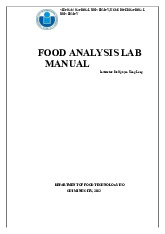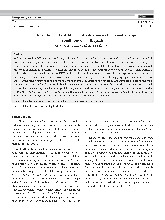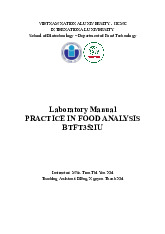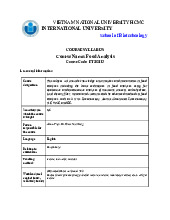




Preview text:
VIETNAM NATIONAL UNIVERSITY HCMC
INTERNATIONAL UNIVERSITY School of Biotechnology COURSE SYLLABUS
Course Name: Food Analysis Course Code: FT332IU 1. General information Course
This subject will provide knowledge on principles and instruments in food designation
analyses including the basic techniques in food analyses using for
qualitative and quantitative analyses of moisture, protein, carbohydrate,
lipid, dietary fiber, mineral and vitamins and the advanced methods in food
analyses such as UV/Vis Spectroscopy, Atomic Absorption Spectroscopy, TLC, HPLC, and GC. Semester(s) in 5,6 which the course is taught Person
Assoc. Prof. Dr. Pham Van Hung responsible for the course Language English Relation to Compulsory curriculum Teaching
lecture, lab works, seminar. methods
(Estimated) Total workload: 70 h Workload (incl.
Contact hours (please specify whether lecture, exercise, laboratory session, etc.): 45 h for contact hours, lecture self-study hours) 1
Private study including examination preparation, specified in hours1: 25 Credit points 03 Required and Food Chemistry recommended prerequisites for joining the course Course
At the conclusion of the course, students should achieve the following: objectives
get the basic knowledge on the principles of chemical analysis.
get the basic knowledge on the advanced analysis methods using for food analysis.
apply a suitable analysis technique for a certain food component.
Course learning Upon the successful completion of this course students will be able to: outcomes
Competency level Course learning outcome (CLO) Knowledge
CLO1. Having the basic knowledge on the principles and
the advanced analysis methods using for food analysis
CLO2. Applying a suitable analysis process for a certain food component Skill
CLO3. Having good skill in the food analysis and data interpretation Attitude
CLO4. Working on group for presentation
1 When calculating contact time, each contact hour is counted as a full hour because the organisation of the schedule,
moving from room to room, and individual questions to lecturers after the class, all mean that about 60 minutes should be counted. 2 Content
The description of the contents should clearly indicate the weighting of the content and the level.
Weight: lecture session (3 hours)
Teaching levels: I (Introduce); T (teach); U (Utilize) Week Content Weight Level 1 Introduction to food analysis 1 I 2
Total dried basis and moisture Ash 1 T, U and mineral analyses 3 Protein & Lipid analysis 1 T, U 4
Spectroscopy: basic principles 1 T, U UV/Visible Spectroscopy 5
- Spectroscopy: Quantitative analysis 1 T, U - Total protein analysis 6
Total carbohydrate and total phenolic 1 T, U analysis 7
Atomic absorption spectroscopy (AAS) 1 T, U 8 Group presentation 1 1 I, U 9
Principles of chromatography and Thin 1 T, U layer chromatography (TLC) 10
HPLC: column, mobile phase, sample, 1 T, U detector, analysis techniques 11 Gas Chromatography (GC): 1 T, U
introduction, column, analysis theory, detector 12
Amino acid composition analysis 1 T, U 13
Fatty acid composition analysis 1 T, U 14 Sugar composition analysis 1 T, U 15
Vitamin & Mineral composition analysis 1 T, U Examination Written test forms Study and
Attendance: A minimum attendance of 80 percent is compulsory for the class examination
sessions. Students will be assessed on the basis of their class participation. requirements
Questions and comments are strongly encouraged.
Assignments/Examination: Students must have more than 50/100 points overall to pass this module. 3 Reading list - Textbook:
1. Food Analysis by S. Suzanne Nielsen, Fifth Edition, Kluwer Academic/Plenum
Publishers, New York, NY, 2017
- Articles in peer-review journals in the field of Food Science
2. Learning Outcomes Matrix (optional)
The relationship between Course Learning Outcomes (CLO) (1-…) and Program/Student
Learning Outcomes (SLO) (1 -…) is shown in the following table: SLO CLO 1 2 3 4 5 6 7 1 x 2 x 3 x 4 x
3. Planned learning activities and teaching methods Learning Week Topic CLO
Assessments activities Resources Introduction to food analysis Lecture, 1 1 Discussion Textbook
Total dried basis and moisture Assignment, Lecture, 2 Ash and mineral analyses 1,2,3 Lab works Discussion Textbook Protein & Lipid analysis Assignment, Lecture, 3 1,2,3 Lab works Discussion Textbook
Spectroscopy: basic principles Lecture, 4 UV/Visible Spectroscopy 1 Discussion Textbook
- Spectroscopy: Quantitative analysis Lecture, 5 - Total protein analysis 1,2,3 Assignment Discussion Textbook
Total carbohydrate and total phenolic analysis Assignment, Lecture, 6 1,2,3 Lab works Discussion Textbook
Atomic absorption spectroscopy (AAS) Lecture, 7 1,2,3 Assignment Discussion Textbook Group presentation 1 Group 8 1,2 presentation Q&A Articles 9 Midterm 4
Principles of chromatography and Thin layer Lecture, 10 chromatography (TLC) 1,2 Discussion Textbook
HPLC: column, mobile phase, sample, detector, Lecture, 11 analysis techniques 1,2 Discussion Textbook
Gas Chromatography (GC): introduction, Lecture, 12
column, analysis theory, detector 1,2 Discussion Textbook
Amino acid composition analysis Lecture, Group Discussion, Textbook, 13 1,2 presentation Q&A articles
Fatty acid composition analysis Lecture, Group Discussion, Textbook, 14 1,2 presentation Q&A articles Sugar composition analysis Lecture, Group Discussion, Textbook, 15 1,2 presentation Q&A articles
Vitamin & Mineral composition analysis Lecture, Group Discussion, Textbook, 16 1,2 presentation Q&A articles 17 Final exam 4. Assessment plan Assessment Type CLO1 CLO2 CLO3 CLO4 90%Pass 90%Pass Assignment (30%) 80%Pass 90%Pass Midterm (30%) 80%Pass 80%Pass Final (40%)
Note: %Pass: Target that % of students having scores greater than 50 out of 100.
5. Date revised: March 10, 2022
Ho Chi Minh City, …../03/2022
Head of Food Technology Department 5



